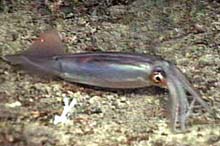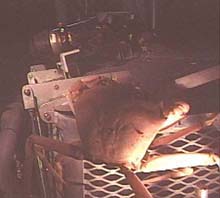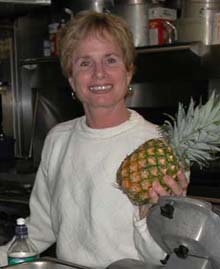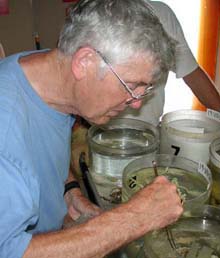
A squid found by the observers aboard the JSL during a dive at Site 3. Click image for a larger view.
A View from the Window
August 28, 2002
Dr. Peter Herring
Southampton Oceanographic Center
Southampton, U.K.
The oceanic habitat invites superlatives: “largest”, “deepest”, “darkest”, “most inaccessible” and “most fascinating” immediately spring to mind. Awakening this morning to the erratic motion of our small floating home and the thrum of its hydraulics and propulsion, I am struck by the colossal bravado (and sheer impertinence) of our efforts to understand it better. Taking a shower, slippery and unsighted, as the vessel rolls me about, is the first reminder that routine activities are no longer routine. Confidence in our human superiority has rapidly to be abandoned in favor of respect for the dynamics of the medium on which we bob so precariously. We are but a speck on its surface yet we are confident that our endeavors will yield new information about its inhabitants and generate new methods for their study. The trick is to work with it rather than against it. My first research cruise in 1962 was to a location in the Sargasso Sea, not far from where I am now, and in the continuous swells and seas my early appearance probably matched the greenness of my experience. Recovery was quick after the first two days but on return I was surprised to find myself land sick in the unusual stability of my first shower ashore! Happily the enthusiasm of those early days has never abated and I see the same excitement and optimism in my companions on the Seward Johnson. It is a privilege for us all to be part of this expedition and its objectives.

This golden crab (Chaceon fenneri) appears to have no fear of the Johnson-Sea-Link submersible. Click image for a larger view.
Exploration of the deep ocean and its inhabitants has advanced by conceptual and technological leaps and bounds from the solid achievements of the early pioneers who set the foundations of our present knowledge. Most of my career has been spent getting to know better the inhabitants of the deep ocean and interpreting their remarkable adaptations. Until the 1970s nets, dredges and corers provided the only realistic means of sampling the midwater and bottom-living animals. I thought (with some reservations) that the thousands of samples I had taken, from all depths, gave me a good feel for the variety and activities of the oceans inhabitants. With the opportunity to go and see for myself in the submersibles, that comfort zone was rapidly dispersed. The dead and dying animals in the tail of a net are damaged (and sometimes completely destroyed) by the abrasion of the net and by “cooking” as they are dragged through the relatively hot surface waters, on the way up from the coolness of their normal surroundings. Their appearance and behavior when viewed from the submersible is quite different. A stuffed owl tells us little about its daily life; a preserved comb jelly or anglerfish is equally mute. Spend some time in the woods at night and the owl comes alive; spend some time down in the ocean and so does its inhabitants. For example, not only can we recognize and admire the intricacy and delicacy of design of the ocean’s jellies (instead of painful reconstructions from the gelatinous debris in the net), but we can also appreciate their importance in the economy of the ocean. The submersible allows us to capture single animals and bring them back to the ship’s laboratory undamaged, still immersed in their own cold water. They reward us with stunning displays of bioluminescence and other responses that we could never have imagined from the mush in the net.
Each small piece of information fits into one or more of the jigsaw puzzles that make up the life stories of each organism in the sea. We shall never complete the puzzles, but the pictures are gradually becoming clearer. Our terms are scientific but that does not prevent us from appreciating the delicacy and beauty of the fauna. My view from the submersible of the ocean floor 1,700 feet below the surface includes white glass sponges, indignant pink crabs, orange anemones, wandering rattail fishes, waving fronds of finger-like gorgonians in red, yellow and cream, and white coral. Careful collection brings up these animals for study on board and reveals further wonders of their life. The glass sponges, for example, are constructed of an intricate tracery of long silica spicules that provide great strength and rigidity for their wineglass or cylindrical shapes. Cutting one open to test its tissues for bactericidal properties reveals a pair of small equally glass-clear shrimps trapped permanently within the sponge. They were once small enough to enter through one of the pores in the sponge’s skeleton, but have outgrown the entrance and have become incarcerated zoo-like within a safe, but limited cage. The developing eggs carried by the female show the success of this lifestyle, despite the limits to the pair’s horizons.
We can trawl for live animals by using a special insulated capture bucket on the tail of the net. We want to know why so many bottom-living deep-sea animals have large eyes, so we need to establish what those eyes can see by recording their electrical responses to lights of known brightness and color. Trawls and traps can give us the intact animals to work with, but take time to haul back to the surface. As we wait impatiently for the midnight trawl’s return, the conversation is far from academic. Fuelled by popcorn and Snickers we discuss the complexities of a common language in which some of us talk of boots when we mean trunks, and bonnets when we mean hoods. Other more vulgar divergences are also considered and English and Australian explorers join in rare linguistic alliance in the face of overwhelming American odds. No wonder the English and the Americans have been described as divided by a common language!
Dr Samuel Johnson, the great essayist and compiler of the first English dictionary, did not like seagoing. He said that “no man should be a sailor who has enough contrivance to get himself into jail, for being at sea is like being in jail with the added possibility of being drowned”. In his (17th century) view jail was more comfortable, the rations better and the company more agreeable. What arrogant nonsense - but he would have made an entertaining addition to our pre-trawl discussion group.
Dr. Peter Herring is author of the recently-released book, entitled The Biology of the Deep Ocean, Oxford University Press, 2002

Bobby Bixler, Chief Seward of the R/V Seward Johnson, enjoys her galley. Click image for a larger view.
Interview with Bobbie Bixler, Chief Steward
R/V Seward Johnson
What are your responsibilities on this Expedition?
I am responsible stocking the ship with general supplies, food, and household goods. I am also responsible for menu planning and meal preparation.
How did you get interested in this work?
I was a sailor and I started working on yachts. I basically went around the world doing that. I got to live in a lot of places and you get to see the people that live there and how they live. Two years ago, I came on board temporarily for three weeks with Harbor Branch Oceanographic Institution. Then it ended up being three months and they kept calling me back. In February of this year, I started working full time on the Seward Johnson II. Now I am full time on the Seward Johnson.
What do you like most about your work?
I like that I can do my own thing. I like that I have enough space to get into the things I want to enjoy and enough time to so. When you are working on yachts, you don’t have the time to do what you want and there is not as much space as there is out here on science ships. I really enjoy the people as well.
What do you find most challenging about your work?
It’s challenging trying to please everybody because you can’t. It also can be challenging to come up with new dishes all the time. I would like to go back to cooking school for a short time to learn some new things…I really do like my job.
Sign up for the Ocean Explorer E-mail Update List.
















































